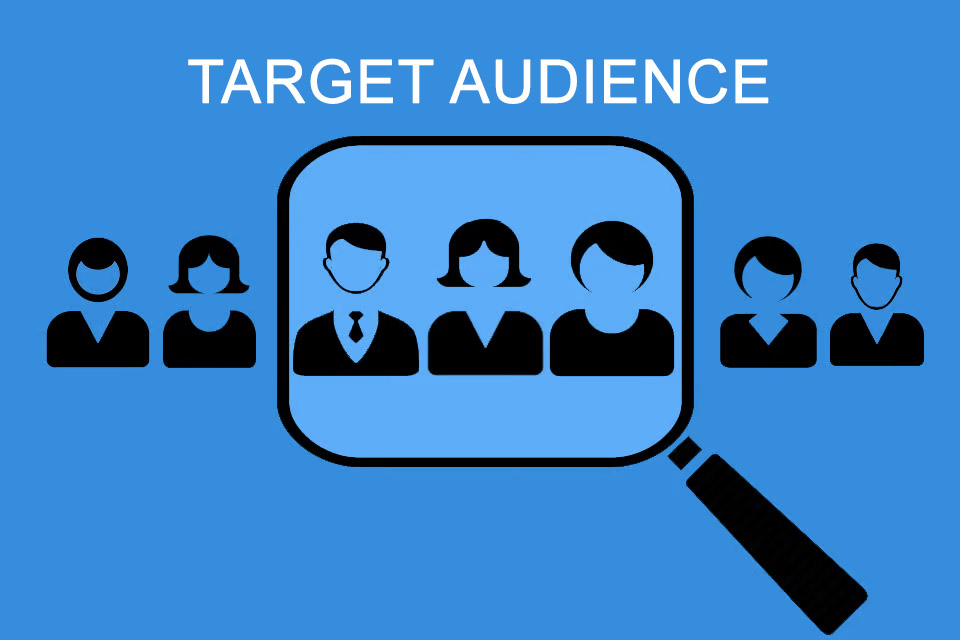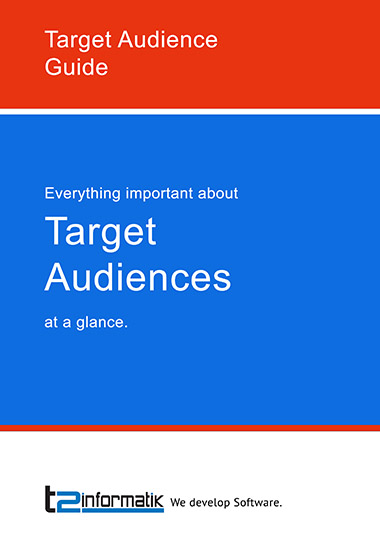What is a Target Audience?
Table of Contents: Definition – Characteristics – Example of a description – Tips – Questions from the field – Download – Notes
Smartpedia: A target audience is a group of people described by characteristics and addressed with defined activities, services or products.
Target Audience – A Group of People with Common Characteristics
Whoever wants to offer a service or develop a product should be able to answer an important question: Who should use the service or who will use the product? The answer to this question helps the provider to develop a service or a product that offers advantages to potential customers while fulfilling their wishes and needs. These potential customers are the recipients of services, the users of products and the addressees of activities. In other words, they are the target audience.
A target audience is a group of people described by characteristics and addressed with defined activities, services or products.
Characteristics to determine the target audience
There are a number of features that organisations can use when defining target groups or market segmentation. These differ depending on the market. In a consumer market or in a B2C market these are typically
- demographic characteristics such as age, sex, marital status, place of residence, household type and household size.
- socio-economic characteristics such as educational attainment, occupation and disposable income.
- psychographic characteristics such as values, opinions, wishes, motivation and lifestyle.
In addition, there are also
- purchase and consumption-oriented characteristics such as price sensitivity, innovativeness, purchasing range or media usage.
If a company develops services and products for other companies, i.e. if it is active in the B2B market, other characteristics help to determine the target audience:
- organisational characteristics such as company size, location(s), type of company, industry, etc.
- economic characteristics such as turnover, profits, market share, liquidity, etc.
- purchasing behavior such as frequency, time period and timing of purchases, supplier loyalty, selection processes, partner programs, etc.
Furthermore there are also
- personal characteristics such as role, motivation, responsibility, budget, decision-making authority, etc.
Especially these personal characteristics should not be neglected in a B2B market, because organisations consist of people and people have – besides the mentioned characteristics in connection with a role – also values, opinions and wishes. And people are usually those who use services and products.
Example of a target audience description
“Department managers are our target audience” – when you hear such a statement, you should be wide awake. The role of a person in the hierarchy of an organisation is one characteristic, but only one among many. There are department managers who have 5 employees and others who have 1,000. There are department managers who are allowed to release amounts up to 5,000 Euro and others are responsible for several millions. A target group definition based on only one characteristic is therefore not enough.
Here you can find an example of a target audience description in the B2B market:
The target group consists of 45 – 65 year old department heads who are responsible for IT departments with a size of 100 – 300 employees.The company is based in Germany, the company language is German. The employees work remotely at different locations or in the home office. The company has been active in the automotive industry as a manufacturer or supplier for at least 10 years, its turnover is more than 10 million Euro per year. The department heads have a budget of more than 500,000 Euro for investments in the development or procurement of individual software. They have more than 10 years of management experience and value partners who work continuously on site, are available 365 days a year, are professionals in agile software development, and have industry experience and contacts to other manufacturers and suppliers. They are technically minded, have personal experience as software architects or developers, value quality more highly than price and image and prefer medium and long-term win-win situations.
Tips for target audience analysis
There are a number of challenges to be overcome when defining target audiences. Here you will find some hints and tips for target audience analysis:
- Finding access to information on groups of people is often difficult and time-consuming. So use every opportunity to talk to customers, potential users or partners to better understand their needs.
- Similar to a stakeholder analysis, it is advisable to deal with target groups in detail. Questioning techniques, observation techniques or creativity techniques can help with the definition.
- The definition of target audience is not a wishful thinking. It is not about defining “the ideal customer”, but about determining those persons for whom an organisation will become active.
- Target groups are often relatively abstract. One way to get from an abstract to a personalised description is the persona concept. Personas illustrate typical representatives of a target audience. They have expectations, values, wishes and goals and show human behaviour. As prototypes of a target group they help to make assumptions about customers or users. However, they do not represent the average of a target audience, but appear as persons who recognise patterns in user behaviour. For this reason companies often develop several personas as representatives of a target group.
- Groups of people are often inhomogeneous. Just because demographic and socio-economic or organisational and economic characteristics coincide, wishes, opinions and competences can differ.
- Even if each defined characteristic reduces the subset of people to be addressed in relation to the total, it is important to determine characteristics. The more precisely you know your target audience, the better you can address suitable services, products or activities.
- Target groups can be unstable over time, as characteristics change over time. For example, sales, market shares and budgets can shrink, or decision-making powers can be reduced.
In principle, it is advisable to continuously review the target group definition and to adjust it if necessary.
Questions from the field
Here are some questions and answers from the field:
Who Defines the Target Audience?
If the target audience definition is merely a “subsequent” determination of groups of people to be addressed with suitable advertising, companies miss opportunities. This is reflected, for example, in definitions such as “The target audience defines a group of people that a company wants to reach with its marketing measures in order to sell products or services to them.”
How significant is the demand of the target group?
Companies define their target groups with the help of the criteria mentioned. But one thing, one prerequisite is often missing (or remains unmentioned): the demand.
Without a clear demand – i.e. a need for which financial means are available to satisfy it – the target audience definition is incomplete. The demand is a basic prerequisite for determining the groups of people with whom companies want to do business. What good is the best target group definition if the addressed target persons have no interest or need or lack the means to satisfy the need through a purchase?
In a comprehensive approach to target audience definition, it is therefore crucial to define potential customers with demand. Only when the demand is clearly identified is the subsequent marketing and sales effort worthwhile.
What is the ongoing challenge when working with target audiences?
When defining target audiences, companies are concerned with identifying the characteristics of target groups. It is important to determine the people with their challenges, wishes and needs with whom the company would like to do business and for whom the company can offer appropriate products and services. The result of the target group definition is often the ideal target customer.
However, the cooperation must not only be lucrative for companies, but also for their target customers. In theory this sounds much easier than it is in reality. For example, a company might try to increase prices in order to maximise profits, but this is unlikely to please the target customers. Establishing a lasting balance in the relationship between the company and its target customers is therefore an ongoing task. Defining target groups may not be an activity that is questioned every day, but engaging, accessing and communicating with the target group is an ongoing activity. For many companies this permanent activity is a major challenge.
How does the value proposition canvas help when working with target audiences?
- Customer tasks: What tasks does a customer have to complete and what goals does he want to achieve?
- Pains: What hinders the customer in completing his tasks, what is missing and why does he feel bad?
- Gains: What can make the customer’s task easier, what does he dream of and how does he feel after achieving his goals?
A company must develop a value proposition for these areas in the form of:
- products and services
- pain relievers or problem solutions
- gain creators or benefit providers
Ideally, the products and services will help the customer to complete his tasks, overcome challenges and satisfy needs. As a result, companies can use various tools such as prototypes or minimum viable products to gradually develop the problem solutions and benefits that the customer wants.
What are personas?
As fictional users, personas are described with specific characteristics such as name, photo, place of residence, CV, marital status, age, income, education, skills, attitudes, hobbies, etc. However, they do not represent the average of a target group, but appear as individuals who recognise patterns in usage behaviour. For this reason, companies often develop several representatives of a target group.
What is an ICP?
Typically, the following factors are taken into account when defining an ICP:
- Company data (e.g. industry, company size, location)
- Revenue/finances (e.g. annual revenue threshold at which the product makes sense)
- Technological equipment (e.g. software stack, IT maturity)
- Purchasing behaviour (e.g. how they buy, how long decision-making cycles are)
- Problem areas/needs (what challenges does this company face)
- Use case fit (does the product fit the company’s processes?)
Defining a clear ICP brings a number of advantages. It enables companies to make their sales and marketing activities much more efficient, as they can focus specifically on those companies that are most likely to benefit from the product or service. This not only improves the quality of the leads generated, but also the probability of closing a sale. In addition, a clearly defined ideal profile ensures that marketing messaging is more accurate, as it can be tailored to specific challenges and needs. The return on investment (ROI) of marketing campaigns also increases because wastage is minimised. Product teams also benefit because they have a better understanding of the type of customer they are developing for. Last but not least, an ICP promotes collaboration between marketing and sales – both departments work towards a common goal, which simplifies coordination and speeds up processes.
Impulse to discuss:
In highly individualised times, does it still make sense at all to deal with the definition of target groups?
Notes:
If you like the article or would like to discuss it, please feel free to share it in your network. And if you have any comments, please do not hesitate to send us a message.
Here you can find a German-language video on defining target groups and buyer personas.
Here you can find additional information from the t2informatik Blog:




